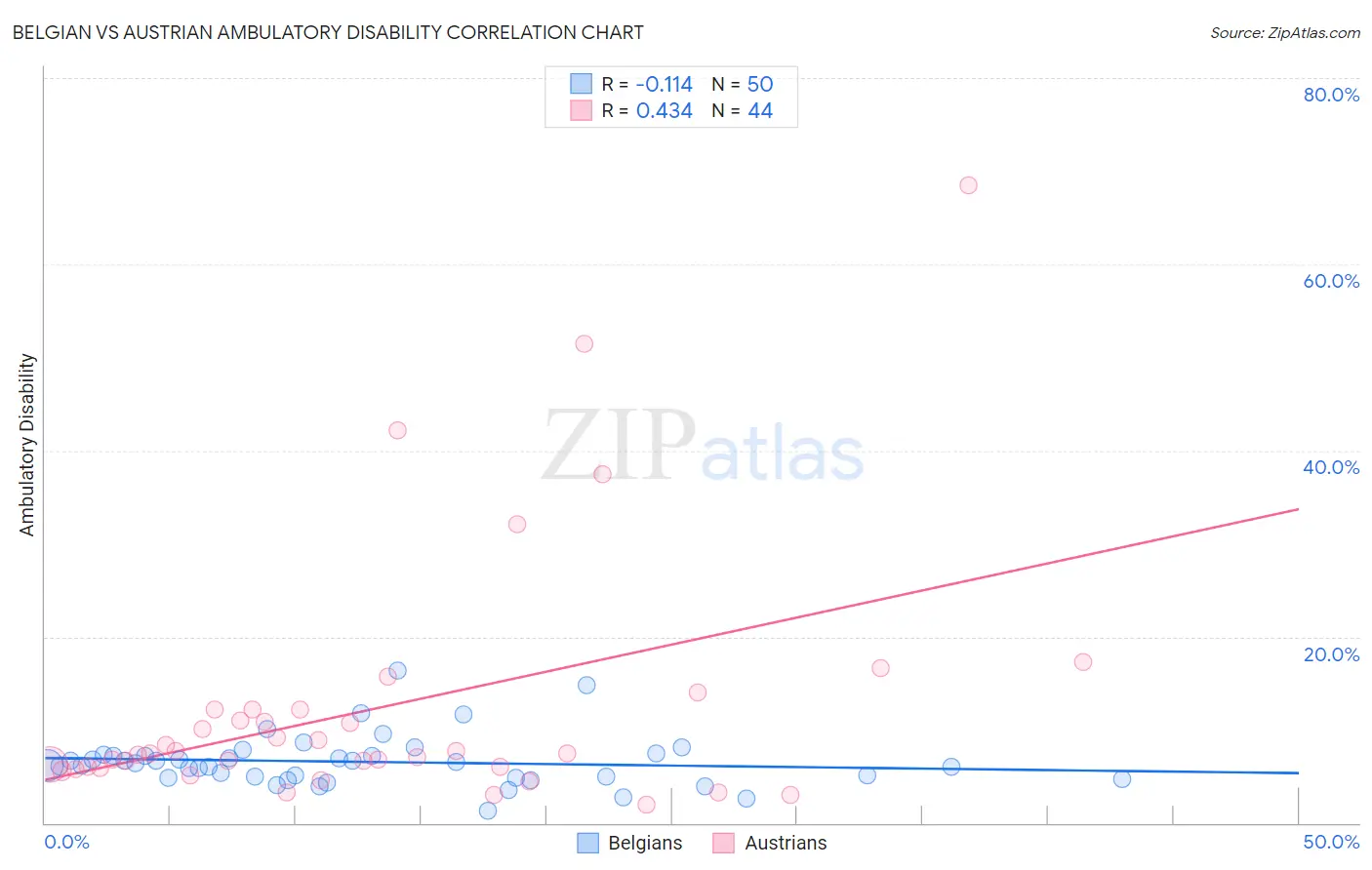Belgian vs Austrian Ambulatory Disability
COMPARE
Belgian
Austrian
Ambulatory Disability
Ambulatory Disability Comparison
Belgians
Austrians
6.2%
AMBULATORY DISABILITY
28.6/ 100
METRIC RATING
195th/ 347
METRIC RANK
6.1%
AMBULATORY DISABILITY
44.1/ 100
METRIC RATING
179th/ 347
METRIC RANK
Belgian vs Austrian Ambulatory Disability Correlation Chart
The statistical analysis conducted on geographies consisting of 355,928,519 people shows a poor negative correlation between the proportion of Belgians and percentage of population with ambulatory disability in the United States with a correlation coefficient (R) of -0.114 and weighted average of 6.2%. Similarly, the statistical analysis conducted on geographies consisting of 451,962,555 people shows a moderate positive correlation between the proportion of Austrians and percentage of population with ambulatory disability in the United States with a correlation coefficient (R) of 0.434 and weighted average of 6.1%, a difference of 0.89%.

Ambulatory Disability Correlation Summary
| Measurement | Belgian | Austrian |
| Minimum | 1.3% | 2.0% |
| Maximum | 16.4% | 68.4% |
| Range | 15.1% | 66.4% |
| Mean | 6.6% | 12.4% |
| Median | 6.3% | 7.5% |
| Interquartile 25% (IQ1) | 4.9% | 6.0% |
| Interquartile 75% (IQ3) | 7.2% | 12.2% |
| Interquartile Range (IQR) | 2.3% | 6.2% |
| Standard Deviation (Sample) | 2.8% | 13.5% |
| Standard Deviation (Population) | 2.7% | 13.4% |
Demographics Similar to Belgians and Austrians by Ambulatory Disability
In terms of ambulatory disability, the demographic groups most similar to Belgians are Malaysian (6.2%, a difference of 0.030%), Guatemalan (6.2%, a difference of 0.080%), Alaska Native (6.2%, a difference of 0.080%), Polish (6.2%, a difference of 0.15%), and Immigrants from Western Europe (6.2%, a difference of 0.19%). Similarly, the demographic groups most similar to Austrians are Immigrants from Nicaragua (6.1%, a difference of 0.010%), Scandinavian (6.1%, a difference of 0.020%), Swiss (6.1%, a difference of 0.050%), Immigrants from England (6.1%, a difference of 0.070%), and Serbian (6.1%, a difference of 0.070%).
| Demographics | Rating | Rank | Ambulatory Disability |
| Immigrants | England | 45.4 /100 | #177 | Average 6.1% |
| Scandinavians | 44.5 /100 | #178 | Average 6.1% |
| Austrians | 44.1 /100 | #179 | Average 6.1% |
| Immigrants | Nicaragua | 43.9 /100 | #180 | Average 6.1% |
| Swiss | 43.1 /100 | #181 | Average 6.1% |
| Serbians | 42.8 /100 | #182 | Average 6.1% |
| Immigrants | Thailand | 42.2 /100 | #183 | Average 6.1% |
| Immigrants | Ghana | 41.2 /100 | #184 | Average 6.1% |
| Immigrants | Bosnia and Herzegovina | 37.2 /100 | #185 | Fair 6.2% |
| Europeans | 36.2 /100 | #186 | Fair 6.2% |
| Carpatho Rusyns | 35.3 /100 | #187 | Fair 6.2% |
| British | 34.3 /100 | #188 | Fair 6.2% |
| Ukrainians | 34.0 /100 | #189 | Fair 6.2% |
| Immigrants | Western Africa | 33.4 /100 | #190 | Fair 6.2% |
| Immigrants | Guatemala | 31.9 /100 | #191 | Fair 6.2% |
| Immigrants | Western Europe | 31.6 /100 | #192 | Fair 6.2% |
| Guatemalans | 30.0 /100 | #193 | Fair 6.2% |
| Alaska Natives | 29.8 /100 | #194 | Fair 6.2% |
| Belgians | 28.6 /100 | #195 | Fair 6.2% |
| Malaysians | 28.2 /100 | #196 | Fair 6.2% |
| Poles | 26.3 /100 | #197 | Fair 6.2% |